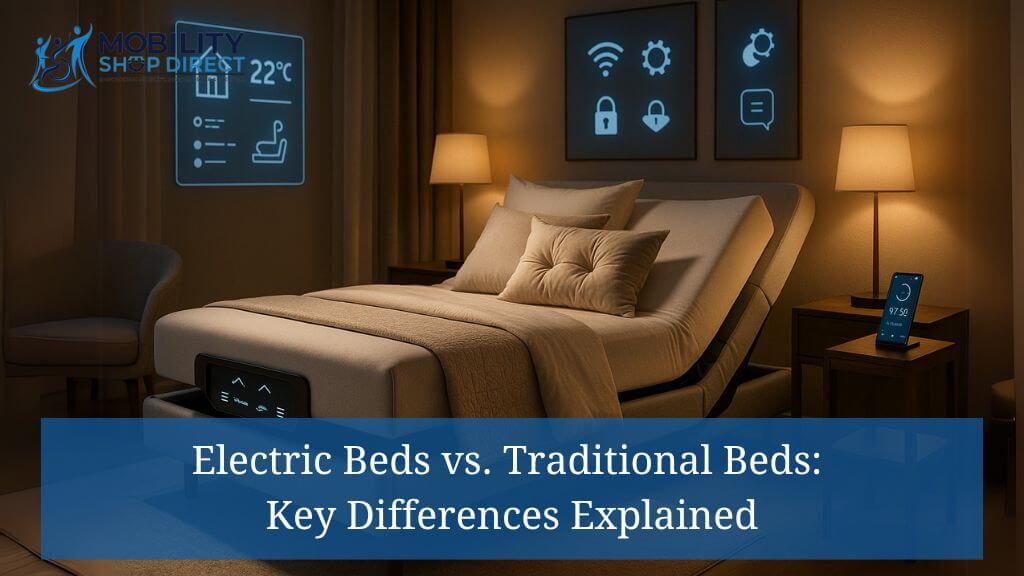When it comes to something as personal and vital as sleep, the right bed can affect not only how rested you feel but also your overall quality of life. This decision goes beyond comfort—your bed influences your posture, health, and even your daily energy. With so many options out there, how do you choose between the familiar simplicity of a traditional bed and the advanced features of an electric adjustable model? The answer depends on your budget, lifestyle needs, and long-term goals.
In this guide, we’ll look at the key differences, advantages, and trade-offs of both electric and traditional beds. We’ll compare cost, comfort, upkeep, health benefits, and available technology to help you figure out what suits your life best. Whether you want added features or prefer a no-fuss solution, the info here will help you make a practical choice.
Let’s start by breaking down what sets these two types of beds apart.
Table of Contents
- Understanding Electric Beds vs. Traditional Beds
- Cost Comparison: Electric Beds vs. Traditional Beds
- Comparing Comfort and Adjustability
- Setup and Maintenance Requirements
- Health Benefits and Medical Applications
- Technology Integration in Electric Beds
- Which Bed Type Is Right for You?
- Key Takeaways
- Conclusion
Understanding Electric Beds vs. Traditional Beds
What Are Electric Beds and How Do They Work?
Electric beds, also called adjustable or motorized beds, let you change the bed’s shape using a remote. Motors lift the head, feet, or both. Some even recline into ergonomic positions.
Many models also include massage functions, temperature control, and mobile app features. These extras are especially useful for people with health issues or who simply want more control over their sleep setup. If you're curious about these kinds of features, our guide on how electric beds work breaks it down in more detail.
What Are Traditional Beds?
Traditional beds are fixed-frame options like box springs or platform beds. Comfort comes from the mattress, not the frame. They’re simple, easy to set up, and don’t need any tech to function.
If you want reliability without any adjustments or electrical components, a traditional bed is a straightforward choice.
Cost Comparison: Electric Beds vs. Traditional Beds
Initial Investment: Electric Bed Costs
Electric beds usually cost more up front. Basic models start around $1,000 and can go past $10,000 for top-tier designs with massage modes or smart tech. Split models for couples also cost more.
Traditional Bed Costs: More Affordable Options
Traditional setups can be as low as $300, even with a decent mattress. High-end options tend to max out around $3,000. There are no electronics to maintain, which keeps long-term costs low.
Is the Investment Worth It?
For people with sleep issues, chronic pain, or mobility concerns, the extra cost of an electric bed might be worth it. But if you’re comfortable and sleep well as-is, a traditional bed might be all you need.
Check out this breakdown of electric bed pricing in Australia to get a better idea of what’s available at each price point.
Comparing Comfort and Adjustability
Unique Comfort Features of Electric Beds
With electric beds, you can adjust your sleep position for better support. This is helpful for issues like snoring, acid reflux, or joint pain. Many offer “zero-gravity” settings to reduce pressure on your spine.
The Static Design of Traditional Beds
Traditional beds can be very comfortable with the right mattress, but they don’t offer the same level of adjustment. If you need to elevate your head or legs, you’ll likely rely on extra pillows.
Who Benefits Most from Customizable Bed Features?
People with chronic conditions, the elderly, pregnant women, and post-surgery patients may benefit most. Adjustable beds offer comfort and flexibility that traditional frames simply can’t.
We’ve outlined specific health benefits of electric beds that are backed by research if you're looking for more detail.
Setup and Maintenance Requirements
How Electric Beds Are Set Up
Electric beds usually take longer to assemble and may require help from a technician. Over time, you might need to service motors or replace parts, although this isn’t frequent with good models.
Minimal Maintenance of Traditional Beds
Traditional beds are easy. Set up the frame, drop in the mattress, and you’re done. There are no moving parts to maintain, which keeps upkeep simple.
Key Comparison: Hassle-Free Setup vs. Long-Term Care
If you want something that’s ready to go and easy to move, traditional beds are hard to beat. But if you’re okay with a little extra setup, electric beds offer more in the long run. For tips on keeping your setup in good shape, take a look at this guide on maintaining electric beds.
Health Benefits and Medical Applications
How Electric Beds Enhance Sleep Quality
By adjusting positions, electric beds can reduce back pain, ease swelling, and help with breathing issues. Elevating the legs can relieve varicose veins, and raising the head helps reduce snoring and reflux.
Traditional Beds and Health Considerations
Traditional beds support general comfort but may not meet the needs of someone with mobility or circulation issues. The right mattress helps, but the frame doesn’t offer much support adjustment.
Medical Use Cases: Electric Beds for Seniors and Nursing Care
Electric beds are common in aged care and recovery environments. Their adjustability helps both the person using the bed and the caregiver. You can also browse our full range of electric beds for options tailored to seniors or those needing medical support.
Technology Integration in Electric Beds
Advanced Features in Electric Beds
Many electric beds now come with app control, voice commands, and even health tracking. Features like sleep timers, massage settings, and smart home syncing offer a very personalized experience.
Lack of Tech in Traditional Beds
Traditional beds keep things simple. No buttons, remotes, or software—just the basics. That’s part of the appeal for many people.
Future-Proofing Your Sleep Technology
If you're setting up a smart home or like connected devices, an electric bed fits right in. If not, sticking to a traditional setup might be the better route.
Which Bed Type Is Right for You?
Factors to Consider When Choosing
- Budget: Are you okay spending more up front for extra features?
- Comfort: Do you need adjustments to sleep better?
- Health: Any conditions that affect your rest?
- Technology: Do you want smart features or prefer simplicity?
Making a Decision Based on Your Priorities
If you need flexibility, comfort, and smart features, electric beds are a strong choice. If you want a simple and affordable setup, traditional beds do the job well.
Key Takeaways
- Electric Beds: Best for users who need adjustable comfort and health support.
- Traditional Beds: Affordable, easy to maintain, and simple to use.
- Health Needs: Electric beds offer more benefits for specific conditions.
- Technology: Electric beds suit modern setups; traditional ones keep things classic.
Conclusion
Choosing between an electric and a traditional bed comes down to comfort, budget, and your specific needs. If you need flexibility and support, or just like extra features, electric beds are a worthwhile investment. If you prefer simplicity and a lower price, traditional beds will serve you well.
The best bed is the one that helps you sleep well and wake up ready. Decide based on what matters most to you, and choose a setup that supports your rest and your routine.



